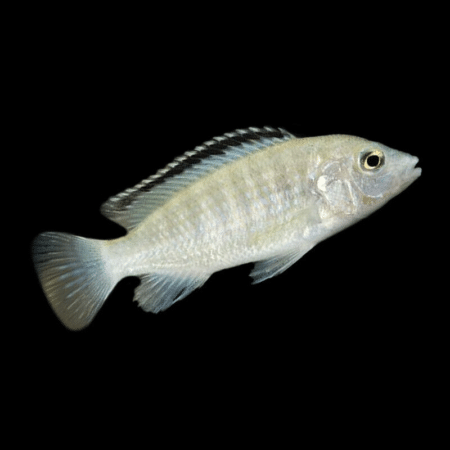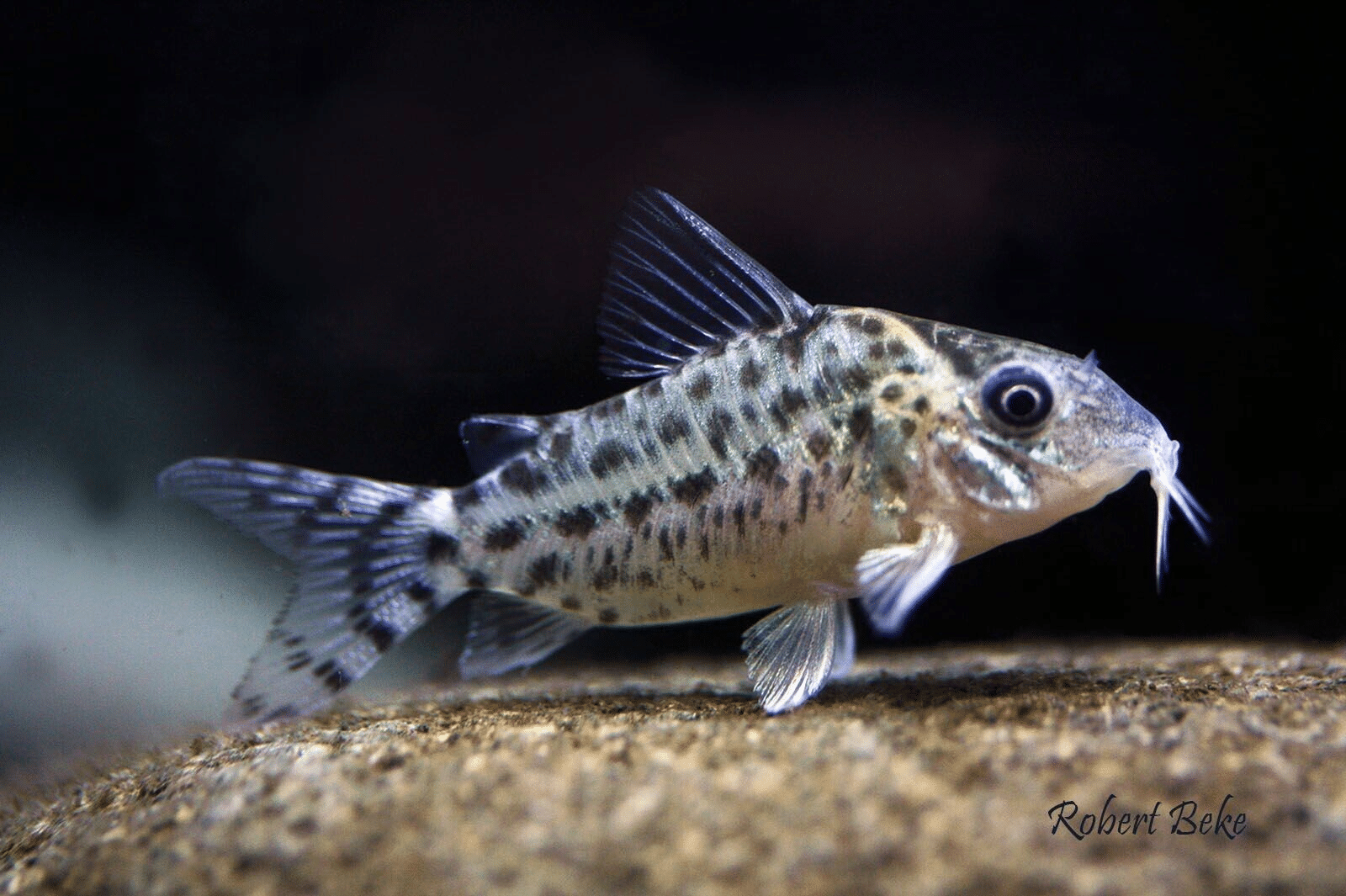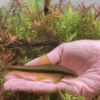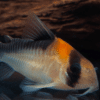Subtotal: £37.74
Spotted Cory Corydoras Agassizii South American Catfish, Best Freshwater Catfish for Community Tanks, Easy Care and Beautifully Unique for Home Aquarists, Perfect for Peaceful Aquariums
£18.49 Original price was: £18.49.£15.48Current price is: £15.48.
Welcome these beautiful Spotted Cory Corydoras Agassizii into your community tank! Their stunning spotted patterns and vibrant colors make them ideal peaceful companions. Perfect for aquarists who value elegance and harmony, these bottom-dwelling fish thrive in clean environments.
1001 in stock
Species Introduction
The Spotted Cory, scientifically known as Corydoras Agassizii, is a charming species of freshwater catfish hailing from the lush waters of South America. These delightful bottom-dwelling fish are primarily found in slow-moving rivers and streams, where they thrive among the sandy substrates and dense vegetation. Their natural habitat features a rich assortment of aquatic plants, which they use for shelter and foraging. Spotted Corys are particularly noted for their striking appearance, characterized by a unique pattern of spots that adorn their smooth, streamlined bodies. This captivating coloration not only adds visual interest to any community tank but also serves as a reminder of the vibrant ecosystems from which they originate. As peaceful and sociable creatures, Spotted Corys are an excellent choice for aquarists looking to create a harmonious community aquarium setup.
Care Requirements Dashboard
| Optimal Living Conditions | |
|---|---|
| Water Temperature | 22-28°C (72-82°F) |
| pH Level | 6.0-7.5 |
| Water Hardness | 2-15 dKH |
| Minimum Tank Size | 120L (30 gal) |
| Salinity | Freshwater |
| Care Level | Beginner to Intermediate |
✓ Care Level: Easy
Tank Size: Minimum 20 gallons
Water Temperature: 72°F – 78°F
pH Level: 6.0 – 8.0
Hardness: 2 – 15 dGH
Natural Behavior & Temperament
Spotted Corys are known for their engaging and playful behavior, making them a favorite among fish enthusiasts. These bottom-dwelling fish exhibit a natural tendency to scavenge the substrate for food, often seen darting around in small groups. They are social creatures and thrive in the company of their own kind, so it is recommended to keep them in groups of at least six to ensure they feel secure and exhibit their natural behaviors. Their peaceful temperament makes them ideal companions for a variety of community tank fish, as they are non-aggressive and tend to avoid confrontation. Observing Spotted Corys interact with their environment and each other can be a delightful experience, as they often engage in playful antics and display a range of social interactions.
Tank Setup Guide
Creating an optimal environment for Spotted Corys involves replicating their natural habitat as closely as possible. A tank size of at least 20 gallons is recommended to provide ample swimming space and to maintain stable water parameters. The substrate should consist of fine sand or smooth gravel, allowing these fish to forage comfortably without injuring themselves. Incorporating plenty of aquarium plants is essential, as they provide hiding spots and contribute to the overall aesthetic of the aquarium. Additionally, driftwood and rocks can be used to create a more complex environment, offering both shelter and foraging opportunities. Ensure that the tank is equipped with a gentle filter to maintain water quality without creating strong currents, as Spotted Corys prefer calm waters. Regular maintenance, including water changes and substrate cleaning, will help keep the tank environment healthy and thriving.
Water Quality Management
Maintaining optimal water quality is crucial for the health and well-being of Spotted Corys. They thrive in water temperatures ranging from 72°F to 78°F, with a pH level between 6.0 and 8.0. It is essential to monitor these parameters regularly using reliable test kits to ensure they remain within the recommended ranges. The hardness of the water should be kept between 2 to 15 dGH, as these fish are adaptable but perform best in slightly softer water. Regular water changes of 25% every two weeks will help remove toxins and maintain a stable environment. Additionally, using a high-quality water conditioner can help neutralize harmful chemicals and chlorine present in tap water. A well-maintained aquarium not only supports the health of your Spotted Corys but also enhances the overall beauty of your aquatic display.
Feeding & Nutrition
Feeding Spotted Corys a balanced diet is essential for their growth and vitality. These fish are omnivorous and thrive on a varied diet that includes high-quality sinking pellets, flakes, and frozen or live foods such as brine shrimp, daphnia, and bloodworms. It is recommended to feed them small amounts two to three times a day, ensuring that they consume the food within a few minutes to prevent water quality issues. Incorporating vegetable matter, such as blanched zucchini or spinach, can also be beneficial for their digestive health. Observing their feeding behavior can provide insights into their preferences and help ensure they are receiving a well-rounded diet. Providing a diverse menu not only supports their nutritional needs but also contributes to their vibrant coloration and overall health.
Compatibility Guide
Spotted Corys are known for their peaceful nature, making them excellent candidates for community tanks. They generally coexist harmoniously with a variety of fish species, including tetras, rasboras, and other small, non-aggressive fish. However, it is crucial to avoid housing them with larger or aggressive species that may view them as prey. When selecting tank mates, consider the temperament and size of potential companions to ensure a balanced community. Additionally, keeping them in groups of six or more will help reduce stress and encourage natural schooling behavior. Regular observations of interactions within the tank can help identify any compatibility issues, allowing for timely adjustments to ensure a peaceful environment for all inhabitants.
Tank Mate Compatibility Guide
Great Tank Mates
- Other peaceful community fish
- Corydoras catfish
- Small tetras
- Peaceful dwarf shrimp
Avoid These Tank Mates
- Aggressive cichlids
- Large predatory fish
- Fin nippers
Compatibility Note: Always research specific species requirements and observe fish behavior when introducing new tank mates. Individual fish personalities can vary!
Health & Wellness
Maintaining the health and wellness of Spotted Corys involves regular monitoring and preventive care. Common health issues include ich, fin rot, and bacterial infections, which can arise from poor water quality or stress. Signs of illness may include lethargy, loss of appetite, or visible lesions on the body. To prevent these issues, ensure that water parameters remain stable and that the tank is adequately cycled before introducing new fish. Quarantining new arrivals for at least two weeks can help prevent the introduction of diseases into the main tank. Additionally, providing a stress-free environment with plenty of hiding spots and appropriate tank mates can significantly contribute to their overall well-being. If any health concerns arise, prompt action and consultation with an aquatic veterinarian may be necessary to ensure the best outcomes for your fish friends.
Breeding Information
Breeding Spotted Corys can be a rewarding experience for dedicated aquarists. These fish are egg layers and typically breed in groups. To encourage breeding, provide a separate breeding tank with soft, slightly acidic water and plenty of fine-leaved plants or spawning mops for the females to lay their eggs. The ideal temperature for breeding is around 75°F to 80°F. Once the eggs are laid, the adult fish should be removed to prevent them from eating their offspring. The eggs will hatch within 3 to 5 days, and the fry can be fed infusoria or finely crushed flakes until they are large enough to consume larger foods. Providing optimal conditions and care during this delicate stage is crucial for the survival and growth of the fry. Observing the entire breeding process can offer valuable insights into the life cycle of these beautiful catfish.
Acclimation Process
Introducing Spotted Corys to a new tank requires careful acclimation to minimize stress and ensure a smooth transition. Begin by floating the sealed bag containing the fish in the aquarium for about 15-20 minutes to equalize the temperature. After this, gradually introduce small amounts of tank water into the bag over the course of an hour. This process helps the fish adjust to the new water chemistry. Once acclimated, gently release the Spotted Corys into the tank using a net to avoid adding any transport water that may contain harmful substances. It is essential to monitor their behavior closely during the first few days in their new home, as they may be shy initially. Providing plenty of hiding spots can help them feel secure as they acclimate to their new environment.
Long-term Care
Long-term care for Spotted Corys involves understanding their lifecycle and growth expectations. These fish typically reach a size of around 2 to 3 inches and can live for 5 to 10 years with proper care. Regular monitoring of their health, water quality, and dietary needs is essential to ensure they thrive throughout their lifespan. As they grow, it may be necessary to adjust tank conditions and companions to accommodate their needs. Additionally, maintaining a consistent feeding schedule and providing a balanced diet will support their growth and vitality. Engaging with your Spotted Corys regularly will enhance your bond with these aquatic companions and enrich your experience as an aquarist.
Natural Habitat Recreation
Recreating the natural habitat of Spotted Corys in your aquarium can greatly enhance their well-being and happiness. Consider incorporating elements such as sandy substrates, driftwood, and a variety of live plants to mimic the lush environments they thrive in. The addition of natural decorations not only provides shelter and foraging opportunities but also contributes to the overall aesthetic appeal of the aquarium. Utilizing native plants and materials can help create a biotope that reflects their natural surroundings, promoting a sense of security and comfort for these beautiful catfish. By prioritizing their natural habitat, you will foster a thriving community tank that showcases the beauty and diversity of aquatic life.
Seasonal Care Adjustments
Seasonal changes can impact the care requirements for Spotted Corys, necessitating adjustments to their environment. During warmer months, it is important to monitor water temperatures closely to prevent overheating, as these fish prefer stable conditions. Conversely, in cooler months, maintaining appropriate heating and ensuring that the tank does not experience drastic temperature fluctuations is crucial. Additionally, lighting schedules may need to be adjusted to mimic natural day/night cycles, promoting healthy growth and behavior. Regularly checking water parameters and making necessary adjustments will help ensure the ongoing health and happiness of your Spotted Corys throughout the year.
Expert Tips
For those looking to enhance their care for Spotted Corys, consider implementing the following expert tips. First, maintaining a consistent feeding schedule with a variety of food types will support their health and coloration. Second, regularly observing their behavior can provide insights into their well-being and help identify any potential issues early. Third, consider creating a layered aquascape with plants and decorations to encourage natural behaviors and provide hiding spots. Lastly, engaging with fellow aquarists through forums or local clubs can offer valuable insights and support for your journey in caring for these beautiful catfish. By staying informed and proactive, you can ensure a thriving environment for your Spotted Corys.
Troubleshooting
Despite best efforts, challenges may arise in caring for Spotted Corys. Common issues include stress from aggressive tank mates, poor water quality, or inadequate hiding spots. If your fish exhibit signs of stress, such as hiding excessively or displaying unusual swimming patterns, it may be necessary to reassess their environment and companions. Additionally, if health issues arise, such as fin rot or ich, prompt action is essential. Quarantining affected fish and treating them in isolation can prevent the spread of diseases. Regular maintenance and monitoring will help mitigate potential problems, ensuring a healthy and harmonious aquarium.
Scientific Background
The Spotted Cory, or Corydoras Agassizii, is part of the family Callichthyidae, which encompasses a diverse group of freshwater catfish known for their unique adaptations and behaviors. This species was first described in the 19th century and has since become a popular choice among aquarists due to its hardiness and peaceful nature. Research into the taxonomy and ecology of Corydoras has revealed valuable insights into their role within aquatic ecosystems, highlighting their importance as scavengers and indicators of environmental health. Conservation efforts are crucial to protect their natural habitats, as many freshwater ecosystems face threats from pollution and habitat destruction. By understanding the scientific background of Spotted Corys, aquarists can appreciate their beauty and significance in the aquatic world.
Advanced Care Techniques
For experienced aquarists looking to elevate their care for Spotted Corys, consider implementing advanced techniques such as creating a species-specific breeding tank or utilizing natural filtration methods. Breeding tanks can be optimized with specific water conditions and plant types to encourage spawning behaviors. Additionally, exploring the use of live foods can enhance their diet and promote natural foraging behaviors. Implementing a natural filtration system, such as a planted tank with beneficial bacteria, can help maintain water quality while creating a more sustainable environment. By embracing advanced care techniques, aquarists can foster a thriving community that showcases the beauty and diversity of Spotted Corys.
Frequently Asked Questions
Q: What tank size is required for Spotted Corydoras?
Spotted Corydoras, or Corydoras agassizii, thrive in a minimum tank size of 60 litres (approximately 15 gallons). A larger tank is preferable as it allows for adequate swimming space and helps maintain stable water parameters. These social fish should ideally be kept in groups of at least six, which promotes their natural behaviour and reduces stress. Ensure that the tank is well-filtered and provides hiding spots, as these creatures enjoy exploring their environment and may seek refuge amongst plants and decorations.
✓ Expert Tip
Consider adding a sandy substrate, as it is gentler on their delicate barbels, allowing them to forage comfortably.
Q: What water parameters do Spotted Corydoras require?
Spotted Corydoras prefer slightly acidic to neutral water, ideally with a pH range of 6.0 to 7.5. The water temperature should be maintained between 24°C and 27°C (75°F to 81°F). Regular water changes of 10-20% weekly are essential to keep nitrate levels low and maintain overall water quality. Additionally, ensure that ammonia and nitrite levels remain at zero, as these can be harmful to your aquatic companions. Regular testing using reliable kits will help you monitor these parameters effectively.
✓ Expert Tip
Consider using a sponge filter to provide gentle water movement while maintaining excellent filtration.
Q: How often should I feed Spotted Corydoras?
Feeding Spotted Corydoras should be done 2-3 times a day, providing only as much food as they can consume within a few minutes. A varied diet is crucial for their health; consider high-quality sinking pellets, freeze-dried or frozen foods like bloodworms, and vegetable matter such as blanched peas or zucchini. This diversity not only enhances their nutritional intake but also mimics their natural foraging behaviour. Overfeeding should be avoided, as it can lead to poor water quality and health issues.
✓ Expert Tip
Try scattering food across the substrate to encourage natural foraging behaviour.
Q: What are the best tank mates for Spotted Corydoras?
Spotted Corydoras are peaceful and social, making them excellent companions for a community tank. Suitable tank mates include small to medium-sized fish such as tetras, rasboras, and guppies. Avoid aggressive or larger species that may see them as prey or disrupt their peaceful nature. It’s important to ensure that all tank mates share similar water parameters and dietary needs. Furthermore, maintaining a group of at least six Corydoras will help them feel secure and display their natural behaviours.
✓ Expert Tip
Introduce new tank mates gradually to reduce stress and ensure compatibility.
Q: How do I properly acclimatise Spotted Corydoras to my aquarium?
Acclimatisation is crucial for the health of your Spotted Corydoras. Begin by floating the sealed bag in your aquarium for about 15-20 minutes to equalise the temperature. After that, gradually introduce small amounts of tank water into the bag over the next hour. This process helps them adjust to the water parameters. Once acclimatised, gently net the fish into the tank, avoiding adding bag water to your aquarium to prevent contamination. This careful approach reduces stress and promotes a successful transition.
✓ Expert Tip
Keep the lights dim during acclimatisation to reduce stress on your new aquatic companions.
Q: What are the signs of healthy Spotted Corydoras?
Healthy Spotted Corydoras exhibit vibrant colours, clear eyes, and active behaviour. They should swim gracefully and not exhibit signs of distress, such as gasping at the surface or hiding excessively. Their fins should be intact, and they should not display any signs of disease, such as spots, lesions, or abnormal swelling. Regular observation is essential to ensure they are feeding well and interacting with their tank mates. Any changes in behaviour or appearance should be addressed promptly to maintain their health.
✓ Expert Tip
Regularly monitor your Corydoras for signs of stress or illness, and address any water quality issues swiftly.
Q: How do I successfully breed Spotted Corydoras?
Breeding Spotted Corydoras can be a rewarding experience. To encourage breeding, maintain a separate breeding tank with soft, slightly acidic water and provide spawning sites such as flat stones or breeding mops. A temperature increase to about 28°C (82°F) can stimulate spawning. Once the eggs are laid, remove the adults to prevent them from eating the eggs. The eggs will hatch in 3-5 days, and fry should be fed infusoria or finely crushed flakes until they grow larger. Ensure the breeding tank is well-oxygenated and maintain regular water changes to keep conditions optimal.
✓ Expert Tip
Keep the breeding tank dimly lit to create a comfortable environment for the breeding process.
Q: What temperature should I maintain for Spotted Corydoras?
The ideal temperature range for Spotted Corydoras is between 24°C and 27°C (75°F to 81°F). This range mimics their natural habitat in South America, where they are found in warm, slow-moving waters. Maintaining a stable temperature is crucial, as fluctuations can stress your fish and make them more susceptible to disease. Using a reliable aquarium heater and thermometer will help ensure that the temperature remains consistent. Regular monitoring is essential, especially during seasonal changes.
✓ Expert Tip
Avoid placing the heater near water flow to ensure even temperature distribution throughout the tank.
Q: How long do Spotted Corydoras typically live in captivity?
With proper care, Spotted Corydoras can live for 5 to 10 years in captivity. Their longevity is influenced by water quality, diet, and overall tank conditions. Regular maintenance, including water changes and monitoring for diseases, plays a significant role in their lifespan. Providing a balanced diet rich in nutrients will also contribute to their health and longevity. Observing their behaviour and appearance will help you catch any potential issues early, ensuring they thrive for many years.
✓ Expert Tip
Keep a journal of your water parameters and fish health to track their progress and any changes over time.
Q: What type of substrate is most suitable for Spotted Corydoras?
Spotted Corydoras prefer a soft substrate, such as sand or fine gravel, which is gentle on their delicate barbels. This type of substrate allows them to forage naturally without injury. Avoid sharp or coarse materials that could cause harm. Additionally, a sandy substrate helps maintain water quality by providing a habitat for beneficial bacteria that assist in breaking down waste. Regular cleaning is necessary to prevent the buildup of harmful substances and to keep their environment healthy.
✓ Expert Tip
Consider adding smooth pebbles and plants to create a natural environment that encourages exploration.
Q: What behavioural patterns should I expect from Spotted Corydoras?
Spotted Corydoras are social and active fish, often seen foraging along the substrate in groups. They exhibit a delightful behaviour of ‘schooling’ together, which is essential for their well-being. These fish are bottom dwellers and prefer to stay close to the substrate, where they can explore and search for food. They may also display playful behaviours, such as darting around or swimming in circles, especially when excited or during feeding times. Observing their interactions can provide insights into their happiness and health.
✓ Expert Tip
Providing hiding spots and plants will encourage natural behaviours and reduce stress.
Q: How can I prevent common diseases in Spotted Corydoras?
Preventing diseases in Spotted Corydoras begins with maintaining excellent water quality. Regular water changes, proper filtration, and monitoring water parameters are crucial. Quarantine new fish before introducing them to your main tank to prevent the spread of disease. Additionally, providing a balanced diet and avoiding overfeeding will strengthen their immune systems. Keeping the tank environment clean and free from debris will also help reduce the risk of infections and parasites.
✓ Expert Tip
Consider adding aquarium salt in moderation to promote health, but consult with an expert before use.
Q: What natural habitat conditions should I replicate for Spotted Corydoras?
To create a suitable environment for Spotted Corydoras, aim to replicate their natural habitat found in South America. They thrive in soft, slightly acidic water with plenty of hiding spots provided by plants, driftwood, and rocks. A dimly lit tank can mimic the dappled light conditions of their natural environment. Additionally, including leaf litter or Indian almond leaves can provide a more natural feel and help maintain water quality. Regularly monitoring water parameters will ensure the environment remains optimal for their health.
✓ Expert Tip
Incorporating live plants can enhance water quality and provide additional hiding spaces.














Emily Carter (verified owner) –
I recently purchased the Spotted Cory (Corydoras Agassizii) and I couldn’t be happier! As a caring fish parent, I prioritize the health and happiness of my aquatic pets, and these little guys have exceeded my expectations. I added them to my 20-gallon tank about two weeks ago, and they’ve already become the joyful stars of my aquarium. Their playful nature and gentle interaction with other fish create such a lively atmosphere.
I love watching them dart around the substrate, sifting through the sand for food. Their elegant spotted patterns not only enhance the tank’s beauty but also help them blend in, which I believe makes them feel more secure. Compared to other catfish I’ve had, I find the Spotted Corys much more sociable and engaging, and they seem to thrive in a well-planted tank.
Just a tip for new buyers: make sure your tank has plenty of hiding spots because they do appreciate a cozy nook or two! Overall, I highly recommend these as the best fish for anyone looking to add personality and charm to their aquarium. They truly are a delight, and I will definitely be getting more of them in the future!
Emily Carter (verified owner) –
I recently added the Spotted Cory (Corydoras Agassizii) to my community tank, and I couldn’t be happier! After about two months, these little bottom-dwelling fish have transformed my aquarium into a lively and colorful environment. They are not only easy to care for but also wonderfully social and active, darting around and playfully interacting with their tank mates. I also appreciate how they help keep the substrate clean, which is a huge plus!
Compared to other catfish I’ve kept, such as the Bristlenose Pleco, the Spotted Corys are much more engaging and much less territorial. Their unique spotted patterns make them visually stunning, especially against a backdrop of lush aquarium plants. My tank is thriving with both flora and fauna, and they seem to love exploring the plants.
A small consideration is that they prefer to be in groups, so I’d recommend getting at least four or five to ensure they feel comfortable and happy. Overall, I wholeheartedly recommend the Spotted Cory to both novice and experienced aquarists. They add such personality and charm to any community tank!